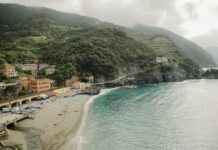In his field in Sully-sur-Loire (Loiret), Robin Lachaux, orange cap screwed on his head, maneuvers his tractor to place the sprinkler in the right place. He directs the reel and fires the water cannon 450 meters further, at the end of his plot.
Return Moments Later?: He checks the settings on the craft screen, it will take about 24 hours for the water cannon, fired by the hose, to return to the reel and finish watering a strip of 450 m long by 70 wide.
Using his phone, the young farmer triggers the pumps of the two boreholes on the farm, located more than a kilometer away. The pipes rise in pressure and the water gushes far away.
To irrigate the entire field, he will have to repeat the maneuver five days in a row.
«If we don’t water today, 50% of the harvest leaves,» says the 30-year-old. «Normally, we do not water this season, but (…) the episodes of drought start earlier and earlier.»
In the Loiret, it rained half as much as usual over the first five months of 2022. A lack of precipitation which comes at a very bad time.
«The wheat is up. We will arrive in the flowering and filling of the grain, so this is the most important period for future yields. No water, no grain», he summarizes, specifying that a small part of his harvest will be sold.
Robin Lachaux is above all a breeder: his farm derives its income from its 90 dairy cows, 300 goats and 8,000 poultry. Wheat, barley and maize are mainly used to feed animals.
«What we fear is that the drought will continue. I have an irrigation capacity of about two months. After a while the flow from the boreholes reduces. So, if I water the wheat correctly, I’m afraid I won’t have enough to water the maize properly until the end of August,» he says.
If the corn grows poorly, the farm will not be able to feed its cows next winter. So you will have to buy food. But, «given the world price of cereals», these expenses will have «a direct impact on the cash flow». And it will not be necessary to count on its barley plots to compensate: non-irrigated, they should experience a «catastrophic yield».
– Abandoned territories –
At the other end of Sully-sur-Loire, Jean-Louis Lefaucheux also monitors his sprinkler. The secretary general of the FNSEA Loiret operates 175 hectares, for a herd of around sixty milkmaids.
«We are on sandy land, the first impacted by the lack of water», explains the trade unionist, while no rain is forecast for the next ten days.
Elsewhere, in the cereal plain of Beauce, the soil retains water better and is therefore still little degraded by drought. But if the sky remains clear, the situation could quickly change, he warns, by crumbling the dry and hard earth.
The farmer draws his water directly from the Loire. But until when?? Prohibitions already apply on small tributaries of the royal river, further upstream. In the region, Indre and Indre-et-Loire also have restrictions.
If the rainfall remains the same, year after year, the rain is now much less evenly distributed. Too much water in winter, not enough in summer.
“It is essential to generalize the storage of water wherever possible. Otherwise, (…) certain territories will be completely abandoned”, he assures. «We are not asking to irrigate at all costs, (…) we are asking to be able to bring water at the right time when we need it.»
The farmer pleads for small water retentions, shared between a few farms, far from the major projects contested by ecological associations and certain peasant unions. The government recently released an envelope of hundreds of millions of euros in this direction.
Climate change has made these «basins» fundamental, according to the trade unionist?: «Food sovereignty will go through water management.»
https://www.lexpress.fr/actualites/1/societe/secheresse-le-dilemme-des-agriculteurs-du-val-de-loire_2173428.html















